Dear San Francisco
Shana Carroll & Gypsy Snider, Co-Creators
A Production of The 7 Fingers at Club Fugazi
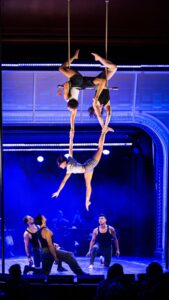
Co-created by choreographic superstars Shana Carroll and Gypsy Snider, Dear San Francisco is ninety-minutes of breath-taking, heart-pumping acrobatics; aerial exhibitions; vaulting bodies; juggling of hats and umbrellas; hoop diving; and so much more. But what makes this intimate-spaced circus San-Francisco-special is also the music, poetry, shadow plays, vintage videos, and recreated City scenes that collectively become a loving postcard to the City by the Bay, its diverse peoples, and its history of time and again rising from disasters into new and even better horizons. The 7 Fingers’ Dear San Francisco is exactly the kind of eye-popping, heart-warming love letter to our Baghdad by the Bay that I am sure all the ghosts of past Club Fugazi performers would approve including the likes of Italian opera singers of the early twentieth century, the beat poets of the ‘50s, Jerry Garcia & the Dead in the ‘60s, Robin Williams in the ‘70s, and the forty-five-year history of the world’s longest running cabaret show, Beach Blanket Babylon, which closed in December, 2019.
As the extravaganza of incredible circus artistry unfolds even amidst the on-stage and in-arena audience, a collage of San Francisco history comes to life all around us – from earthquakes to beat poetry to the Summer of Love to ashes falling from the sky on a day when the sky turned orange. Scattered throughout are the actual words that current audience member have written on “Dear San Francisco” postcards to reveal why this City means so much to them, each read lovingly by various cast members.
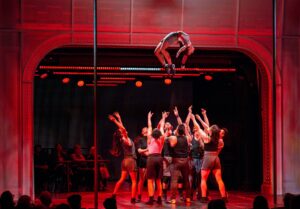
The Cirque du Soleil roots of the show’s founding group, The 7 Fingers, are evident in the highly choreographed, beautifully flowing movement of the nine cast members. The first series of stirring, often stunning stunts by the entire cast is a kind of ongoing, acrobatic dance of bodies flipping and falling, twisting and turning, climbing and collapsing – all occurring around, on, over, under, and through each other’s arms and legs. What will not be the only time of the evening, a body flies suddenly through the air – and even down an aisle between gasping audience members – to be caught at the last possible second before disaster. Another walks upside down across the stage’s ceiling while supported by the cast members below. Three bodies connect vertically to become a City high rise while the set ends with bodies forming the kind of steep hill natives must walk every day, with one member climbing to become what could be taken as a human Sutro Tower.
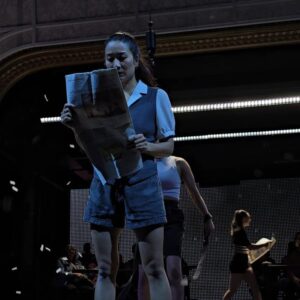
Passersby stroll about reading newspapers as various ones stop into a phone booth (Remember those?) to talk about the Warriors chances next season or to ask Mom to send money. Ashes begin to fall from the sky as heads pop out of the open newspapers and worried eyes look upward. One woman – Zoe Schubert – grabs a descending pair of thick, black strings and begins a series of swings and flips that send her rising and falling body into incredible positions in every direction. With one foot attached, her body hangs from high above, circling in the air like an upside-down ballet dancer.
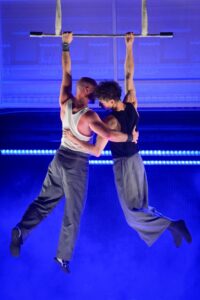
A series of read, audience-written love letters to San Francisco ends with one particularly appropriate as the month of Pride begins – a thank you to a City that supported the writer’s coming out. As Gabriela Diaz plays an enticing number on her accordion – just one of several cast members who are also talented musicians – a muscular guy swings himself onto a rising trapeze, soon to hoist up a second guy, with the two high above in loving embraces while their bodies intertwine in precarious positions on the swing. What follows are beautifully erotic interchanges on the trapeze of every possible gender mix of couples who are watched by mixed and same gender couples on the ground. Soon there is a total stage of dancing and acrobatics as bodies are tossed and caught in another example of a circus act becoming a ballet.
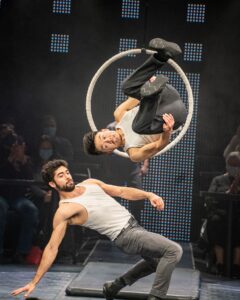
As members recite lines from poets associated with San Francisco – many of whom like Alan Ginsburg and Jack Kerouac read their creations in near-by City Lights during the beat-poetry days of the ‘50s and beyond – a single hoop slowly and continuously rotates and rises foot-by-foot in the next few minutes from ground level to a height much taller than a person stands. With moves full body prone as well as sideways, frontwards, and even backwards, numerous cast members (including Dominic Cruz, Eduardo De Aevedo Grillo, Jose Miguel, and Marinez Gomez) jump through the moving hoop. As the height increases and the initial runway becomes longer for the flying acrobat to launch, the eventual landings come shockingly close to the edge of the stage, startling the first-row audience only inches away.
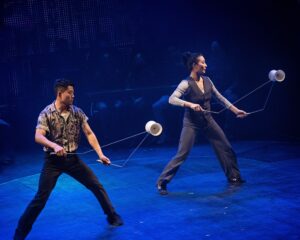
This international, mixed-race cast (Colombia, England, China, Brazil, and U.S.A.) often masterfully showcases acts traditional to other parts of the world. Married couple Shengnan Pan and Enmeng Songdemonstrate thrilling, mind-boggling spinning and tossing – including the entire length of the Fugazi – of the Ming Dynasty originating diabolo, an ancient version of a yo-yo.
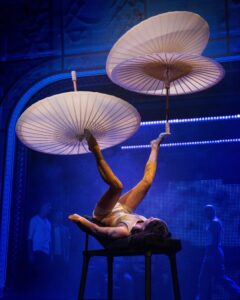
Shengnan Pan also amazes the audience as she foot-juggles one, then two, and finally three Japanese fans. Her artistically stunning display occurs only after cast members write over her entire body words like “loss,” “pain,” “hurt,” “hate,” and “fear” – all reminding us of the current anti-Asian incidents and attacks that have occurred even in highly diverse and overall liberal San Francisco. A shower of water cleanses the performer of all the hateful slurs before she returns to her bench for her climatic, emotionally captivating ending.
Original music composed by Colin Gagné captures the times and the moods of each San Francisco scene. Jake Rodriguez designed the sound that shakes our bones during the recreated, 1906 earthquake (or was it 1989 or one day soon?) and ensures we hear clearly sung lyrics, poems, and words from postcards. The lighting of Christine Cochran and David Lynch create that associated with rainy streets, days in the parks, and nights of fog as well as highlight with amazing accuracy the latest jump, fall, or other feat that we must not miss seeing. Keiko Shimosato Carreiro’s array of costumes serve their utilitarian function for these varied acts of circus as well as provide flavors of the life and times of San Francisco, now and in the past.
Enmeng Song begins bringing the close to an astonishing evening by once more thanking the City for its many gifts. Her heart-felt expressed “You gave me permission to love; you accepted me” is seen in all the faces of the surrounding cast representing a wide mixture of racial, gender-preference, and geographic backgrounds. Appropriately in the tradition of Beach Blanket Babylon which ended each of its shows with a sing-along “San Francisco,” the Dear San Francisco cast invites all of us to celebrate the love-rich traditions of the City by singing together Scott McKenzie’s anthem for the summer of 1967, “If you’re going to San Francisco, be sure to wear some flowers in your hair.”
While Dear San Francisco is the perfect place for that special celebration or for bringing those guests from Back East, Dear San Francisco is also a special night out for all of us who treasure the City, its uniqueness, its diversity, and its love of the performing arts of every sort – each visit begging for a soon repeat.
Rating: 5 E
Dear San Francisco currently is set to run Wednesdays through Sundays through January 5, 2025, at Club Fugazi, 678 Green Street, San Francisco. Tickets are available at http://clubfugazisf.com.
